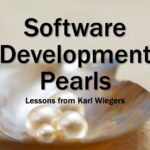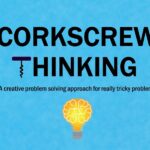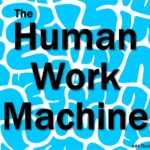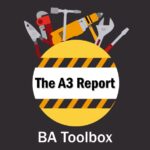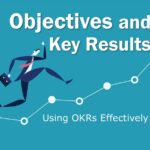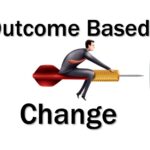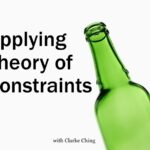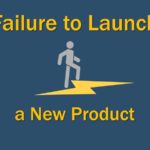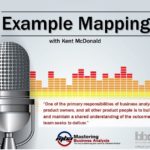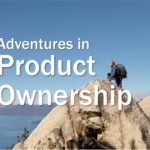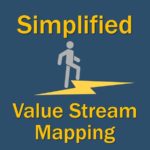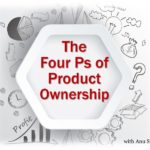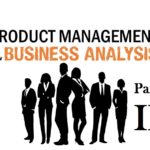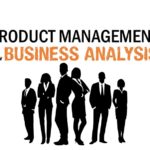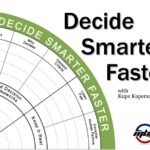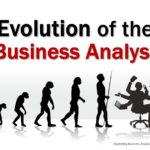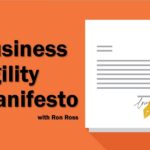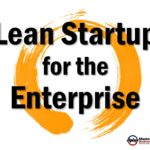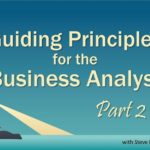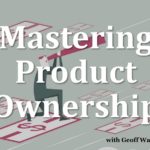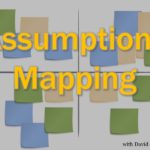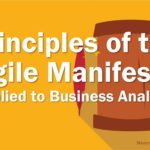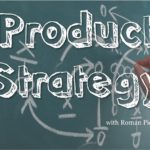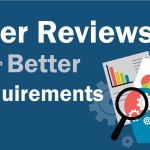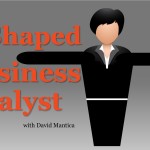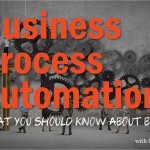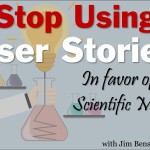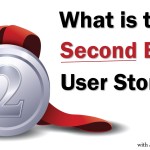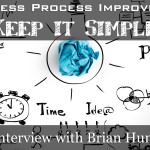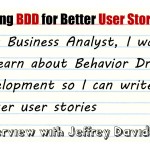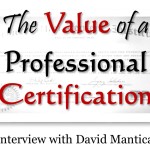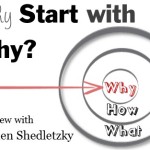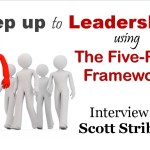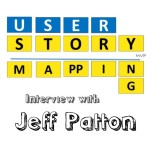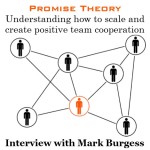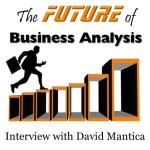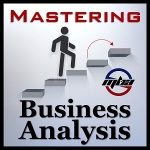Siirry offline-tilaan Player FM avulla!
MBA226: The FOCCCUS Formula
Manage episode 303870469 series 2557282
In this episode, we revisit Theory of Constraints, an approach to improving organizational performance by accelerating delivery. Author Clarke Ching shares his FOCCCUS Formula to address the system’s bottleneck.
Show Notes
In every process or value delivery system, there’s one constraint (bottleneck) that limits the flow of value of the entire system. If you want to deliver faster, you must identify and address the bottleneck. To improve the flow of value, we can apply the Theory of Constraints, a process improvement methodology that focuses on addressing the bottleneck.
Eli Goldratt’s famous book, The Goal, introduced readers to the Theory of Constraints and how to apply Goldratt’s Five Focusing Steps to address your constraint. However, many people are unaware of or confused by the Five Focusing Steps.
In you’re confused about how to address the bottleneck in your process, you can use Clarke Ching’s FOCCCUS Formula instead. FOCCCUS is an acronym that stands for the steps you can take to address the constraint and improve the system.
FOCCCUS
The first step in the FOCCCUS Formula is “F” for find the bottleneck. You can’t improve the bottleneck if you don’t know where it is. To find the bottleneck, look for work piling up of long queues in front of a step in the process. Work typically builds up in front of the constraint.
Once you find the bottleneck, the next step is “O” for optimize. You want to optimize the bottleneck so that it can get work done faster. You can do this by making sure the work that goes to the bottleneck resource is ready (has everything they need) and the bottleneck is focused only on value added work.
After you optimize, the next step is collaborate. Collaboration helps the bottleneck deliver faster because non-bottleneck resources may be able to off-load work that the bottleneck is doing.
In addition to collaboration, you can apply the second “C”, which is coordinate. This step involves finding ways to coordinate activities of both bottleneck and non-bottleneck resources to optimize delivery. This can include rearranging process steps or changing the timing of certain pieces of work to smooth the flow.
The third “C” in the FOCCCUS Formula is curate. When you curate, you decide what to put in a limited amount of space. Essentially, you prioritize work to maximize the value that can be delivered.
The “U” in the FOCCCUS Formula stands for upgrade. This can mean buying faster equipment, holding training to improve skills associated with the constrained task, or hiring more people. Upgrading can be expensive and you should only upgrade after completing the other steps.
The final step is “S”, which stands for start again. The FOCCCUS Formula is a continuous process. After you complete each step, you should validate that the bottleneck hasn’t moved. If it has, continuing to the next step with the same bottleneck won’t improve the flow of value through the system.
Check each time to ensure that you know where the bottleneck is and start with the simplest, cheapest intervention.
Listen to the full episode to understand how to use the FOCCCUS Formula to improve your process and accelerate value delivery.

Clarke Ching
Clarke has been powered by the Theory of Constraints for over 20 years and Agile since 2003. He wrote Rolling Rocks Downhill (the Agile business novel that never mentions Agile) and The Bottleneck Rules (which was featured in The Guardian newspaper, and was briefly the #2 best-selling leadership book on Amazon.com, just behind Steven Covey).
Latest Episodes
- MBA228: Software Development PearlsKarl Wiegers shares his lessons on requirements, project management, design, quality and more. Karl’s advice can make you significantly better at what you do. Show Notes Karl Wiegers started programming in 1970 and has collected 60 lessons he has learned in several areas of software development including requirements, design, project management, culture, teamwork, quality, and […]
- MBA227: The Minimum Viable BusinessIan Reynolds discusses how to discover the right solutions for your customers and then deliver them quickly.
- MBALC: Elon Musk’s 5-Step Design ProcessIn this lightning cast, we explore the 5-step design process Elon Musk uses for SpaceX to innovate and get better results.
- MBA226: The FOCCCUS FormulaThe Theory of Constraints is an approach to improving organizational performance by accelerating delivery. Author Clarke Ching shares his FOCCCUS Formula to address the system’s bottleneck.
- MBA225: The Value of Business ModelsDavid Mantica helps us understand business models and helps us understand how to find new opportunities to create greater value.
- MBA224: Corkscrew ThinkingClarke Ching shares an innovative problem solving approach to help us solve tricky problems.
- MBA223: The Human Work MachineDavid Mantica discusses the brain science behind some of the challenges knowledge workers face and helps you shift your mindset to enable you to thrive in a complex and chaotic environment.
- MBA222: Testing Your Business IdeasDavid Bland discusses the importance of testing your business ideas and shares ways to dramatically reduce the risk and increase the likelihood of success for your product, initiative, or project.
- MBA221: Systems Thinking and Business AgilityAdrian Reed discusses systems thinking, how it enables business agility, and how it can help elevate the value you bring to your organization.
- MBA220: Thoughtless Design with Karl WiegersAuthor and thought leader Karl Wiegers shares principles and lessons he has learned from poor designs and what you can do to develop solutions that create a great user experience.
- MBA219: How To Be an Agile Business AnalystKent McDonald shares his thoughts on what it takes to succeed as a Business Analyst in an Agile environment.
- BA Toolbox – A3 ReportIn this episode of the BA Toolbox, we explore the A3 report and it’s use in problem solving.
- MBA218: Customer-Centric TransformationMelissa Boggs discusses how the Scrum Alliance transformed into customer-centric teams and how you can have a greater customer focus.
- Lightning Cast: Agile PlanningUnderstanding the different levels of Agile planning and what they mean for you will help your team stay aligned and focused on achieving the right outcomes.
- MBA217: Objectives and Key ResultsPaul Niven helps us to understand Objectives and Key Results (OKRs), a goal-setting tool to set ambitious goals with measurable results.
- Lightning Cast: POWER Start for Your MeetingsStop the wasted time and money from ineffective meetings by giving your next meeting a POWER Start.
- MBA216: Outcome Based ChangeDavid Hawks shares an approach to transformations, projects, and large change initiatives by starting with the business outcomes.
- Lightning Cast: Resistance to ChangeOvercome resistance to change using Goldratt’s Four Quadrants of Change
- MBA215: The Challenges with Leading in Product ManagementRoman Pichler discusses the challenges associated with leading in a Product Management role and what you can do to overcome those challenges.
- MBA214: The BA Success PathLaura Brandenburg shares her framework for career development; the Business Analyst Success Path.
- MBA213: Applying Theory of ConstraintsIf you want to accelerate and deliver with greater speed and flexibility that’s critical to serving your customers, combine Agile with Theory of Constraints.
- MBA212: Transforming Your Work with Modern AgileJoshua Kerievsky shares the four principles of Modern Agile and how they can help you find better ways of working and achieve better business outcomes.
- MBA211: Adaptive LeadershipIn this time of unrelenting change, we need leadership at all levels. Here’s what you need to help your team succeed.
- MBA210: Vital CommunicationCommunication is vital to success on teams and across organizations. In this episode, Tommy Re shows us how to dramatically improve communication.
- MBA209: Visual ThinkingGrant Wright Shares simple Visual Thinking tools and practices to help your team get aligned and retain information.
- MBA208: Facilitative LeadershipAuthor Michael Levine helps us unleash the power of large, diverse groups of smart, experienced individuals to deliver positive business results.
- MBA207: Bad Behaviors in the WorkplacePaul Pelletier helps us to understand the root causes of disrespectful behaviors at work and how to address them.
- MBA206: Succeeding with AnalyticsJim Rushton helps us to understand why 80% of analytics projects fail and what you can do to make sure yours succeeds.
- Lightning Cast: BA Goals RevisitedBuilding on last year’s episode about BA performance goals, we discuss how to choose the right goals and achieve them.
- MBA205: Beyond Data LiteracyLori Silverman helps us get real value from data by developing core competence and creating the culture needed to support collaborative data-informed decision making.
- MBA204: Top Skills for 2020LinkedIn’s list of the 15 most in-demand skills includes business analysis and a many skills that are critical to your success.
- MBA203: Career InsuranceDavid Mantica shares ways to protect yourself from layoffs and prepare for career advancement.
- Yes, Virginia, There Are BAs in AgileHoliday Episode: In the style of the 1897 New York Sun editorial, a grown up Virginia asks if there are Business Analysts in Agile.
- Lightning Cast: Failure to Launch (a new product)Find out what you can do to ensure a successful product launch.
- MBA202: Business Value AnalysisDavid Mantica helps overcome one of the biggest challenges facing organizations today – understanding value and building the right solution.
- MBA201: Tips From an Accidental Product OwnerRichard Larson shares his experiences as an accidental Product Owner and provides tips and advice for others moving toward a role in Product Ownership.
- MBA200: Take Action! The Best Advice from Over 200 EpisodesHere’s the best tips and advice from industry experts in over 200 episodes. Now take action!
- MBA199: The Future of the BA ProfessionKevin Brennan discusses how the world of work is changing and how Business Analysts need to adapt.
- MBA198: DevOps – What it Means for BAsMichael Roberts helps us understand what DevOps is and how it affects the role of Business Analysts.
- MBA197: Making Change FunLora McCoy discusses how to shift the psychological response to change and help stakeholders adapt and adopt the change.
- MBA196: Customer Journey Treasure HuntingVince Mirabelli shares some practical, how-to approaches to developing empathy, mapping the customer journey, and finding business process improvement opportunities along the way.
- MBA195: Example MappingKent McDonald shares his thoughts about what you need to know about Agile and how to use Example Mapping; a technique to create a shared understanding.
- MBA194: Start Your Project Off RightAdrian Reed shares approached for successfully initiating projects and stakeholder management
- MBA193: About Your CareerRyland Leyton shares tips and advice from his new book to help you find the right job and grow in your career.
- Lightning Cast: Story Estimation – What’s the Point?Explore the use (and misuse) of story point estimation and discover the right way to estimate stories.
- Lightning Cast: Requirements RotIs your project suffering from requirements rot? As time passes between requirements elicitation and delivery, your requirements will become unusable.
- MBA192: The Blight of Product DebtProduct debt can slow the delivery, erode customer value, and make it difficult to innovate. Here are the different types of product debt and what you can do about it.
- Lightning Cast: The Power to Get Things DoneIn this episode, we discuss the different kinds of power you can use to get things done within your team or across your organization.
- MBA191: Use Cases in AgileUse Cases aren’t just for waterfall. Use Cases also work well in Agile an context and help address the challenges with User Stories.
- Lightning Cast: AI – Can you be replaced by a machine?80% of project tasks will be performed by AI by 2030. Will you lose your job to a machine?
- MBA190: Business Data AnalyticsOrganizations need to make better decisions based on real data. Find out how you can bring value in the area of business data analytics.
- Lightning Cast: You Are a FacilitatorFacilitation means more than running a meeting. Find out how you can facilitate the the value it brings to your organization.
- MBA189: Adventures in Product OwnershipBriElle Bryson shares her experience stepping into a Product Owner role and helps us understand how to prepare for product ownership
- Lightning Cast: Simplified Value Stream MappingEliminate waste in a process and get a holistic view of end-to-end value using a simplified Value Stream Map
- MBA188: The Four Ps of Product OwnershipAnu Smalley shares her 4Ps framework to address a major challenge organizations face today; how to build products customers want and love.
- Lightning Cast: Product DebtAre you suffering from Product Debt? Product Debt erodes customer value, stifles innovation, and increases the time and cost it takes to deliver new functionality.
- MBA187: Transitioning to a Scrum Master RoleDiscover how to leverage your core Business Analyst skills in a different way and be successful as a Scrum Master.
- Lightning Cast: Business AgilityUnderstand the importance of business agility and your role in helping your organization become more responsive to changing customer needs.
- MBA186: Exploring Product OwnershipCoach and author Bob Galen shares some of the challenges Product Owners face, how to overcome them, and how to take your skills to the next level.
- Lightning Cast: Don’t Throw it Over the WallAvoid the epidemic of creating an output and throwing it over the wall to another team.
- MBA185: Business Analysis in AgileJames Robertson shares some of the challenges associated with an Agile transformation and how Business Analysts can provide the most value to the organization.
- Lightning Cast: Non-Functional Requirements in AgileFind out how to make non-functional requirements visible in an Agile context.
- MBA184: Discover What Customers Want with JTBDDiscover unmet customer needs with Jobs to be Done and a unique customer interview technique.
- Lightning Cast: We Are the BusinessBreak down those silos and avoid the “us vs. them” mentality between business and technology.
- MBA183: The BA Role on a Scrum TeamFind out where a Business Analyst fits on a Scrum Team and what they can do to provide value to the team and the organization.
- MBA182: BA in the Service IndustryHow can a Business Analyst apply their skills in a non-technical field? Find out how your current skills and competencies can apply in new contexts.
- Lightning Cast: Death, Taxes, and Missed RequirementsUnderstand the certainty of missing requirements and what you can do to reduce the occurrence and impact of missed requirements
- MBA181: The Three BA ArchetypesUnderstanding the three Business Analyst archetypes can help you find the right job and advance your career.
- MBA180: Socratic QuestioningKent McDonald helps us uncover information and elicit requirements using an ancient questioning technique.
- Lightning Cast: BA Performance GoalsStart your year off right with tips for setting your annual performance goals.
- MBA179: The Power of PrototypingEffective use of prototypes can create a common understanding and develop a feedback loop to help you build better solutions.
- MBA178: Career Options for BAsBusiness Analysis is a critical and highly transferable skill. Here’s how to use it to advance your career.
- MBA177: Product Backlog RefinementProduct Backlog Refinement (grooming) is a key activity for any Agile team. Here are some tips and recommendations for successful refinement sessions.
- MBA176: Predictions for 2019Thought leaders share their predictions for 2019 and what you can do to be more successful in the new year.
- Lightning Cast: A Visit From the Business AnalystIn this Christmas episode, we find out what happens when the BA visits a struggling project team.
- MBA175: Product Management is the New Business Analysis – Part 2Find out the tools and techniques you need to develop a customer-centric focus for product development.
- MBA174: Product Management is the New Business AnalysisAgile and other changes in the way we work means that we need to change too. Here’s how we can leverage our skills and competencies in a new way and grow our careers.
- MBA173: Avoiding the Build TrapProduct Management expert Melissa Perri helps us to avoid some on the pitfalls of solution development and create products customers will love.
- MBA172: Decide Smarter Faster with Kupe KupersmithKupe Kupersmith focuses on approaches that will help you learn quickly, make good decisions, and manage risk.
- MBA171: Your Questions Answered – Listener MailbagIn this episode, I answer questions submitted from listeners. Questions about Agile, DevOps, and remote elicitation are answered.
- MBA170: Persuasion – Get Buy-In for Your IdeasMary Lynn Manns shares techniques you can use to get buy-in for your ideas and influence others to take action.
- Lightning Cast: Big Design Up FrontIn this Lightning Cast, we’ll explore the practice of using stage gates and a big design up front. Why do organizations use the BDUF approach and is there a better way?
- MBA169: Digital Business Analyst CompetenciesIIBA President Ken Fulmer shares eight competencies that are critical for success when working as a digital Business Analyst.
- MBA168: Exploring the BA Career PathAdrian Reed helps us explore the BA career path, career growth options, and actions you can take to grow in your career as a Business Analyst.
- MBA167: The Power of StorytellingWant to communicate in a compelling, memorable way? Storytelling allows you to connect with your audience at an emotional level and helps your ideas stick.
- MBA166: Mastering the Art of FeedbackIn this episode, Heather Mylan-Mains helps us to be effective in giving feedback and how to receive feedback for the greatest impact.
- Special MessageI’ll be unable to post the next episode for a bit. Unfortunately, I’m in the hospital with some issues with my leg.
- MBA165: Remembering Jerry WeinbergHere are some of the most important lessons from Jerry Weinberg in his own words.
- Lightning Cast: Think as a CustomerCreate solutions your customers will love by thinking as a customer.
- MBA164: The Agile Analysis CertificationIIBA President Ken Fulmer discusses the IIBA’s Agile Analysis certification; What it means for your organization and to your career.
- MBA163: Lean Six Sigma – What You Should KnowDiscover how Lean Six Sigma can help you bring value to your organization and be a differentiator for your career.
- Lightning Cast: Moving to a BA RoleFind out how to transition into a Business Analyst role.
- MBA162: The Business Analyst Role and its Real ValueGlenn Brule discusses the Business Analyst role, its real value proposition, and what you can do to increase the value you provide to your organization.
- MBA161: Evolution of the BA RoleWhat’s the next step in the evolution of the role of the Business Analyst? Does Agile spell the end of the BA role?
- Lightning Cast: Dude’s LawUnderstand what you can do to increase the value of products and solutions developed by your organization by using Dude’s Law.
- MBA160: The Art of Better Business RequirementsAlyce Reopelle challenges some of the practices and assumptions we make about requirements elicitation.
- Lightning Cast: Business AgilityDiscover what you can do to help your organization achieve business agility; the ability to quickly adapt to changes and rapidly deliver value.
- MBA159: Experiment Driven DevelopmentIn this episode, you’ll discover how to use hypotheses and experiments to identify the right solutions for customer needs.
- MBA158: Agile RequirementsIn this episode, we’ll explore Agile requirements and answer the question “Are User Stories requirements?”
- MBA157: The Importance of Good Data AnalysisFind out about the impact that good data analysis can have on your organization and how to get started.
- Lightning Cast: Symptoms of SuccessAre you successful? Explore what it looks like to be successful as a Business Analyst or Project Manager.
- MBA156: The Power of MentoringWant to take your skills and your career to the next level? A mentoring relationship can do just that. Discover how to find the right mentor and create an effective mentoring relationship.
- MBA155: Hiring BAs and PMsAre you a hiring manager looking for great BA and PM candidates? Find out how to find the best candidates for your organization. Job seekers will discover how to best prepare for a job search.
- MBA154: Change LeadershipImplementing change in an organization goes beyond requirements and change management. You need Change Leadership to help people adjust to the change. Here’s how!
- Lightning Cast: BA on a Scrum TeamFind out what a Business Analyst does on a Scrum team and how you can use your BA skills in a different way to help the team.
- MBA153: Trends in Business AnalysisElizabeth Larson talks about current trends in the Business Analysis field and how they will affect you.
- Lightning Cast: Powerful QuestionsPowerful questions are a way to challenge our thinking, stimulating deeper conversations, and uncovering hidden truths. Here’s how to ask more powerful questions.
- MBA152: Finding the Right ProjectRichard Larson shares five techniques you can use to discover the underlying problem or opportunity to solve create the right solution.
- Lightning Cast: Order your BacklogA clear, well-ordered backlog leads to more focus, less time in refinement, and delivering the most important items first. Here’s how to order your backlog.
- MBA151: Your Consulting Practice – with Karl WiegersAuthor and consultant Karl Wiegers shares his tips and advice on getting started with consulting.
- Lightning Cast: Which Communications Channel Should You Use?Which communications channel should you use? The right communications medium depends on your message. We’ll explore different forms of communication and which to use in different contexts.
- MBA150: A High Five for Business AnalystsTomette Kirk shares what she calls the high five; five essential tasks that we need to focus on as Business Analysts to be successful.
- Lightning Cast: Common Issues Facing Business Analysts TodayIn this episode, I share common problems Business Analysts face and what you can do about them.
- MBA149: The Power of EQAuthor and speaker Jen Shirkani helps us to understand the importance of Emotional Intelligence and shares with us techniques to boost your EQ.
- Lightning Cast: The Business AlchemistDiscover a different way of thinking about your role and go from Analyst to Alchemist to achieve extraordinary outcomes for your organization.
- MBA148: 7 Keys to Succeeding with AgilePaula Maychruk helps us uncover the key concepts that allow us to be successful with Agile approaches.
- Lightning Cast: Trust – The One Thing that Changes EverythingTrust increases the speed to deliver projects and reduces cost. Here’s how to develop and maintain trust on your team.
- MBA147: The Business Agility ManifestoRon Ross explains the Business Agility Manifesto and helps us to understand the role business knowledge plays in enhancing business agility.
- MBA146: The Full Stack Business AnalystWhat does it take to become a Full-Stack Business Analyst? Similar to a Full-Stack Developer, a Business Analyst can broaden their skills to reduce waste and contribute more value to the organization.
- MBA145: Predictions for 2018Six thought leaders in the fields of business analysis, project management, and Agile share their predictions for 2018 and what you should do to be successful.
- Lightning Cast: Confessions of a Recovering PerfectionistPerfectionism leads to procrastination and fear. Here’s how to overcome perfectionism.
- MBA144: The 12 Days of the ProjectDiscover 12 approaches that lead to shorter time to market, increased customer value, and innovation.
- Lightning Cast: Stepping Up to Product OwnershipDiscover what it takes to transition to a Product Owner role and be successful.
- MBA143: Imposter Syndrome – Banishing Your Inner CriticAuthor and renown speaker Denise Jacobs helps you to overcome Imposter Syndrome and silence your inner critic to unleash your creativity.
- Lightning Cast: Root Cause AnalysisWe explore two common root cause analysis approaches, Fishbone Diagrams and 5 Whys, to help you understand when to use each technique.
- Lightning Cast: Using Competency ModelsDiscover the value of competency models and how they can help you grow in your career.
- MBA142: Lean Startup for the EnterpriseFind out how to apply Lean Startup approaches so that you can build solutions customers will love.
- MBA141: Digital Transformation – What is Means for BAsKevin Brennan helps us to understand the impact of digital transformations and what you need to do to adapt to this shift.
- MBA140: Improve Influence with NLPCorrine Thomas shares techniques from Neuro-linguistic Programming (NLP) that can help you build relationships and influence better.
- Lightning Cast: Better Communication Using the DiSC ModelImprove your communication and collaboration by adapting your approach using the DiSC model.
- MBA139: Thin Slicing Problem AnalysisAdrian Reed helps us avoid developing solutions that don’t address the real opportunity through thin slicing problem analysis.
- Lightning Cast: The Many Uses of a SIPOCIn this Lightning Cast, we explore the many applications of a SIPOC and how it can help you on your next project.
- MBA138: Building a Believable Business CaseRandy Radic shares his process and tips for building a realistic business case to make sure your organization is moving forward with the right initiatives.
- Lightning Cast: Stay in Your LaneShould business stakeholders and technology teams stay on their own lanes and not cross over to other areas?
- MBA137: Challenges with User Stories – with Mike CohnAuthor, trainer, and Agile thought leader Mike Cohn helps us to overcome the challenges with successfully applying User Stories.
- MBA136: What the IIBA Can Do for You – Part2New initiatives from the International Institute for Business Analysis (IIBA) can help you develop your skills and grow in your career.
- MBA135: What the IIBA Can Do for YouCEO and President of the International Institute for Business Analysis (IIBA), Ken Fulmer joins us to discuss some new initiatives at the IIBA and how the IIBA can help you advance your skills and grow in your career.
- Lightning Cast: Flip the Script in Your Job SearchRyland Leyton helps us to flip the script during a job search to be in the right mindset and find the right opportunity.
- MBA134: Distinguishing Yourself in Your CareerRyland Leyton shows us how to distinguish ourselves in interviews and in our career.
- Lightning Cast: Brainstorming – You’re Doing It Wrong!Brainstorming doesn’t work – at least not the way you’re doing it. Here’s a better way.
- MBA133: What BAs Need to Know About AgileDispel the myths and find out what you need to know about working in an Agile environment.
- Lightning Cast: Requirements QualityRequirements quality – What is it and how you can increase the quality of your requirements.
- MBA132: Next Generation CompetenciesIn this episode, Kupe Kupersmith shares a new competency framework for the next generation of professionals in the project field.
- Lightning Cast: The Agile Business Analyst MindsetWhat’s the mindset shift needed to be successful as a Business Analyst in an Agile environment?
- MBA131: Interviewing for a Business Analyst PositionLaura Brandenburg shares tips and advice for acing your next interview for a Business Analyst position.
- Lightning Cast: The Business Analyst Career PathWhat is the Business Analyst career path and how do you grow your career?
- MBA130: Exploring Requirements with Jerry WeinbergJerry Weinberg shares his thoughts on the challenges with software requirements and why we need to take requirements seriously.
- MBA129: Real Life Agile, UX, and Design ThinkingBrent Severson shares how he has successfully integrated Design Thinking, User Experience Design, and Agile into his BA practice to make himself valuable to teams working in the digital space.
- MBA128: Where Should the Business Analyst Reside?Lora McCoy shares her views on where business analysts should reside in an organization to enable better collaboration, growth, and prevent solution bias.
- MBA127: Guiding Principles for the Business Analyst – part 2We conclude our discussion with Steve Blais as he shares with us his 11 principles of the business analyst, which provides guidance as to what a business analyst should do to achieve success.
- MBA126: Guiding Principles for the Business AnalystAuthor and consultant Steve Blais shares with us his 11 principles of the business analyst, which provides guidance as to what a business analyst should do to achieve success.
- MBA125: Become the Conscience of the BusinessIan Huke helps us to become the conscience of the business by doing the right thing, building a following, and becoming a trusted advisor.
- MBA124: Business Analyst in an Agile EnvironmentIn this episode, author Lynda Girvan discusses how BAs can succeed in Agile environments by applying a lean and adaptive approach.
- MBA123: The 21st Century Business AnalystKitty Hass explains the evolution of the Business Analyst role and what you need to do to be successful in the 21st century.
- MBA122: Driving Real Value Through Business AnalysisAlaeddin Hallak shows us ways to deliver real business value through our business analysis approach.
- MBA121: Mastering Product OwnershipGeoff Watts helps us to better understand the Product Owner role and takes us from good to great product ownership.
- MBA120: Jobs to be Done TheoryAlan Klement shows us how Jobs to be Done can help you design better products and spur innovation. Jobs to be Done (JTBD) is a mixture of design thinking, lean startup, and agile to help you make great products that people will love.
- MBA119: What’s in Your Backlog?In this episode, we discuss the different types of items that may make up a product backlog (Hint: It’s more than just User Stories)
- MBA118: Virtual LeadershipDr. Penny Pullan shares strategies for working on virtual project teams and helps us get the most out of virtual teams and virtual work.
- MBA117: Getting Requirements RightJared Wiese shares an approach for focusing on value to help you not just elicit requirements, but to get requirements right.
- MBA116: Implementing Solutions vs Problem SolvingMatt Adams helps us understand what to do when we’re given a solution to implement. His approach leads us to become trusted advisors.
- MBA115: Political Martial Arts – Navigating Office PoliticsPaula Bell shares her tips and advice to break through the red tape and bureaucracy of office politics that holds many projects back.
- MBA114: Value Proposition of the BA RoleDavid Olson discusses the evolution of the Business Analyst role and its true value proposition.
- MBA113: Problem Solving – The RIGHT StuffLearn a problem solving approach that takes you through incovering the right problem, finding the right solution, and putting the right plan into action.
- MBA112: User Centered DesignCaleb Carroll helps us deliver better business value through a User Centered Design approach.
- MBA111: Design Thinking IS Good Business AnalysisExplore the tools of Design Thinking and find out how it helps ensure you build valuable solutions.
- MBA110: Managing Ambiguous RequirementsScott Stribrny shares four techniques to identify and address ambiguous requirements.
- MBA109: Foundations in Business AnalysisGet back to basics and establish a strong foundation for your business analysis skills and techniques.
- MBA108: Prioritizing with the MVPLearn how to find the minimum viable product and use it to identify work that you should deliver first.
- MBA107: Backlog Refinement – From Misunderstanding to Collaborative DiscoveryRichard Dolman helps us take backlog refinement from an underutilized meeting that doesn’t get the respect it deserves to a powerful forum for collaborative discovery.
- MBA106: Rapid Requirements GatheringScott Killen shares an approach for quickly eliciting a majority of project requirements with very little prep work.
- MBA105: The Best Advice I Ever ReceivedThought leaders in Business Analysis share the best advice they ever received.
- MBA104: Predictions for 2017What does the future hold for Business Analysis? Here are my predictions for 2017.
- MBA103: How Mr. Finch Stole the ProjectHear the holiday tale of Mr. Finch as he tries to sabotage the project, read in the style of the popular children’s author, Dr. Seuss.
- MBA102: Product Management – Build the Right ThingRich Mironov helps us to better understand the Product Manager role and what we can do to make sure we build a solution that drives success for our organization.
- MBA101: Split Your Stories!Chris Sims shares four techniques to split your user stories to make them smaller, more manageable, and to help draw out details.
- MBA100: My Biggest MistakeEight business analysis leaders share personal stories of their biggest mistakes and what they learned along the way so you don’t make the same mistakes.
- MBA099: Assumptions MappingDavid Bland shares an exercise from LeanUX for gaining clarity in times of uncertainty and developing a deep understanding of customer needs.
- MBA098: The Art and Science of InfluenceDavid Mantica talks to us about influence and how to successfully navigate any organization to move projects to execution. He also shares several approaches and techniques to improve your ability to influence.
- MBA097: Partnership Between the PM and BAAuthor and consultant Cheryl Lee helps us to improve the collaboration and partnership between Business Analysts and Project Managers.
- MBA096: The Standard for Business AnalysisDavid Bieg, Business Analysis & Requirements Program Manager for the PMI, tells us about PMI’s development of a foundational standard in Business Analysis.
- MBA095: Lean Change ManagementAuthor and international speaker Jason Little helps us to understand how to use Lean Change Management to create change that sticks.
- MBA094: Perspectives in Business AnalysisPeter Leftrov helps us to understand how the BA Perspectives can help you choose which techniques and tasks are applicable to your specific project.
- MBA093: Beyond Project RiskLook beyond typical in-project risks and adopt a systems thinking approach by identifying organizational risks that may come up as a result of your project.
- MBA092: Reducing the Risk of Missing Non-Functional RequirementsRoxanne Miller shares six ways to help reduce the risk of missing non-functional requirements (NFRs).
- MBA091: Going from Order Taker to Trusted AdvisorElizabeth Larson helps us along the path going from order taker to trusted advisor and helps us to avoid some of the common pitfalls.
- MBA090: BABOK 3.0 with Richard LarsonRichard Larson helps us to understand what’s changed in version 3 of the BABOK Guide and how it can help you and your career.
- MBA089: Agile Manifesto – What it Means to Business AnalystsWhat do the principles behind the Agile Manifesto mean in the context of Business Analysis? Same skills as traditional approaches, but applied differently.
- MBA088: Effective Requirements WorkshopsLora McCoy shares her five step process for running effective and engaging requirements workshops and discovering requirements quickly.
- MBA087: Replaced by a Robot – Interview with Kupe Kupersmith
- MBA086: DocOps – Keep Your Documentation Agile
- MBA085: From Models to Stories
- MBA084: Agile Modeling with Scott Ambler
- MBA083: The BA Core Concept Model
- MBA082: Addressing Bottlenecks with Theory of Constraints
- MBA081: User Story Mapping with David Hussman
- MBA080: Think Like a Freak
- MBA079: Effective Collaboration
- MBA078: Design Sprints
- MBA077: Preparing for the Future of Business Analysis
- MBA076: Product Strategy
- MBA075: Slices of Big Truths
- MBA074: Lean Business Analysis
- MBA073: Agile Requirements – What’s DifferentWhat’s different about requirements in an agile environment vs. requirements in waterfall? Success with agile requirements requires a shift in mindset from big design upfront to continuous small, valuable pieces as well as an understanding of when to dive into the details and when to keep the information at a high level.
- MBA072: Improve Your Facilitation
- MBA071: The Essence of Business Analysis
- MBA070: Better BA and PM Collaboration
- MBA069: Business Rules – What You Need to Know
- MBA068: Realities of Being a Product Owner
- MBA067: All About the PMI-PBA Certification
- MBA066: Starting a BA Community of Practice
- MBA065: The Value of Business Analysis
- MBA064: Transitioning to a Product Owner Role
- MBA063: Starting a Career in Business Analysis
- MBA062: Peer Reviews for Better Requirements
- MBA061: Overcoming Roadblocks to Success on Complex Projects
- MBA060: Business Architecture and Business Analysis
- MBA059: Problem Solving for Business Analysts
- MBA058: Reusable Discovery Testing
- MBA057: The 6 Stakeholders You’ll Meet in Project Hell
- MBA056: Design Thinking for Better Business Analysis
- MBA055: The Agile BA – Interview with Ryland LeytonRyland Leyton, author of The Agile Business Analyst: Moving from Waterfall to Agile, joins us to talk about what it means to be an agile business analyst and how to be successful in an agile environment.
- MBA054: Strategy and its Role in Business Analysis
- MBA053: Use Cases and Beyond – with Ivar JacobsonThe father of Use Cases, Dr. Ivar Jacobson, joins us to discuss how he came up with the idea for Use Cases, how to use them in an agile environment, and what lies beyond Use Cases.
- MBA052: Portfolio Management & The Agile Extension
- MBA051: A Visit From the Business Analyst
- MBA050: The T-Shaped Business Analyst
- MBA049: The First Line of Defense Against a Security BreachHans Eckman helps us to understand how the Business Analyst is perfectly suited to be the first line of defense in preventing security breaches. Hans also shares some approaches and advice for handling security related requirements.
- MBA048: Finding the Minimum Viable Product
- MBA047: The DNA of a Great Agile Business Analyst
- MBA046: The Product Owner / Business Analyst Relationship
- MBA045: The Agile BA – Myths and Misconceptions
- MBA044: Business Process Automation
- MBA043: Abuser Stories – Think Like a Bad Guy
- MBA042: Stop Using User Stories – Interview with Jim Benson
- MBA041: What’s the Second Best User Story?James Robertson helps us decompose user stories into smaller, more manageable pieces and look critically at stories so that they don’t specify a solution.
- MBA040: User Stories – Are You Ready?
- MBA039: The Big Deal with Big Data
- MBA038: Use Cases, CX, and UX: Putting it all together
- MBA037: The Key to Better CollaborationJim Tamm shares some essential skills for effective collaboration and practical tools designed to help you manage your own defensiveness, build trust, reduce conflict and create a more collaborative working environment.
- MBA036: Psychology of Leadership – Interview with Cillín HearnsLeadership and performance coach Cillín Hearns helps us explore what it means to be a leader and will show you how to advance your leadership skills regardless of your current role or level.
- MBA035: Active Listening – The Most Important SkillWhat is the single most important skill needed by every business analyst, product owner, and project manager? It’s a skill that allows you to build trust and ensure an accurate, shared understanding. That skill is active listening.
- MBA034: Use Case 2.0 – Interview with Ian SpenceIn this episode, author Ian Spence introduces us to a different way to utilize Use Cases in agile environments – Use Cases 2.0. After listening to this episode, you will understand: The advantages of using use cases How to use cases can be used in an agile environment Why and how to create thin slices of use cases Show Notes […]
- MBA033: Landing and Succeeding in Your First BA Role – Interview with Alex PapworthIn this episode, consultant and blogger Alex Papworth shares his advice for starting a career as a Business Analyst – how to get and succeed in your first role as a BA. After listening to this episode, you will know: How to find opportunities to advance your BA skills and experience How to target your job search […]
- MBA032: Systems Thinking – Interview with Paula BellIn this episode, consultant and author Paula Bell shares her approach to Systems Thinking – a holistic analysis approach to understanding how the parts of an organizational system interrelate. After listening to this episode, you will understand: What Systems Think is and why it’s important How to begin How you can better understand your customers and build […]
- MBA031: UX – Are you Experienced? Interview with Neil TurnerIn this episode, User Experience designer and researcher Neil Turner will share his thoughts on how and when to interact with UX professionals in your company as well as give you some practical tips and tools you can use to create a better experience for your customers. After listening to this episode, you will understand: What […]
- MBA030: Myths and Patterns of Organizational Change – Interview with Linda RisingIn this episode, author, speaker, and consultant Linda Rising helps us to better understand resistance to change and some of the myths and patterns associated with leading organizational change. After listening to this episode, you will understand: The myths of organizational change that lead us down the wrong path Why simply stating facts doesn’t persuade people How […]
- MBA029: Business Process Improvement – Keep it Simple – Interview with Brian HuntIn this episode, Business Process Consultant Brian Hunt shares with us his approach to starting a business process improvement initiative and some simple tools you can use to get started. After listening to this episode, you will understand: How to start a business improvement initiative The right people to talk to to discover improvement opportunities Simple […]
- MBA028: Talking Techie and Presenting Complex Ideas with Melissa MarshallIn this episode, Melissa Marshall will help us to understand how to bridge the gap between technical terms and business terms and present information in a meaningful way. After listening to this episode, you will understand: Why it’s critical to be able to communicate complex information to a general audience How to use an audience […]
- MBA027: Elicit User Requirements with Legos – Interview with Ellen GroveIn this episode, Ellen Grove speaks with us about how to use Legos (the building blocks for kids) to elicit user requirements. This requirements elicitation technique quickly surfaces areas where there is not a shared understanding and identifies gaps missed by other approaches.
- MBA026: Guarding Against Scope CreepScope creep isn’t just the nickname of that weird guy with chronic bad breath down the hall. It also refers to uncontrolled changes or the continuous growth in a project’s scope. Often, this addition to scope comes without corresponding changes to the budget, resources, and schedule. Scope creep is also known as requirements creep and can occur when the project scope is poorly defined and as a result, requirements are added that do not align with the objective of the project.
- MBA025: Don’t Just Make Software, Make an Impact – Interview with Gojko AdzicIn this episode, Gojko Adzic speaks with us about how to deliver solutions that the business truly needs to achieve their goals and avoid creating shelfware. He’ll also introduce us to a tool that he uses called Impact Mapping. After listening to this episode, you will understand: How to focus on creating an impact for your […]
- MBA024: Lead with the Power of a Jedi – Interview with Heather Mylan-MainsIn this episode, we’re joined by Heather Mylan-Mains. Heather is going to share with us how to motivate and inspire as a leader based on her presentation entitled “BA Jedi Master Leadership Academy – Learn How to Lead with the BA Force”. After listening to this episode, you will understand: How Business Analysts can lead […]
- MBA023: Using Behavior Driven Development for Better User Stories – Interview with Jeffrey DavidsonIn this episode, we’re joined by Jeffrey Davidson. Jeffrey will help us to better understand how to get better at user stories and how behavior driven development (BDD) helps create a shared understanding. We also discuss how to create the nirvana state of living requirements. Jeffrey Davidson is the past president of the IIBA Dallas […]
- MBA022: How to Know Where to Focus Your Efforts – Interview with Chris MattsIn this episode, we’re joined by Chris Matts. Chris will introduce us to the Cynefin framework and how he uses it to understand where to focus business analysis activities and where the focus should be more product management driven. Chris also discusses Real Options, which is a decision-making process for managing uncertainty and risk that he developed. […]
- MBA021: Is the Business Analyst Role Just Overhead? Interview with John Sextro“Let’s get rid of Business Analysts and ScrumMasters.” In this episode, we’re joined by John Sextro. John recently gave a provocative lightening talk at a conference about removing Business Analysts and ScrumMasters from agile teams. We’ll discuss what this would mean for the BA role. John Sextro has been in the software industry for 21 years and […]
- MBA020: The Value of Certifications – Interview with David ManticaIn this episode, David Mantica, President of ASPE-SDLC, shares his views on the value of professional certifications – both to the individual and to the organization. David Mantica is president of the American Society of Professional Education Inc. (ASPE-SDLC) and has two decades of experience as a business leader in the training industry. David has participated […]
- MBA019: Why Start with Why? Interview with Stephen ShedletzkyIn this episode, leadership speaker and Start With Why facilitator Stephen Shedletzky helps us understand how to apply the Start With Why concept to our role to help our organizations work on the right things and deliver value to customers. He’ll also share his thoughts on how to inspire others to take action. After listening […]
- MBA018: Step Up to Leadership with the Five-Rule Framework – Interview with Scott StribrnyWhat makes a great leader? In this episode, Scott Stribrny begins to answer this question by presenting a business analyst relevant five-rule framework to apply in real life. Scott will discuss principles that guide effective leaders and will explore the short-term orientation of leadership with examples for day-to-day action as well as the long-term orientation […]
- MBA017: Does Your Communications Engine Need a Tune-Up? Interview with David BarrettIn this episode, David Barrett speaks with us about what I feel is the most important skill for a Business analyst . . . communication. David is the National Program Director for the Centers of Excellence in Project Management and Business Analysis at the Schulich School of Business and is one of the founders of […]
- MBA016: User Story Mapping with Jeff PattonIn this episode consultant, author, and agile thought leader Jeff Patton shows us how to use Story Maps to create a shared understanding of a feature and create thin slices that relate to the minimum viable product and additional releases. Jeff also shares his thoughts on the proper way to use User Stories and how to avoid […]
- MBA015: Promise Theory for Team Cooperation – Interview with Mark BurgessIn this episode, Dr. Mark Burgess, creator of CFEngine, explains how he uses concepts from physics to explain how complex systems work. He uses his Promise Theory to not only develop better computer systems, but also to give us a better framework for individual and team interactions. After listening to this episode, you will understand: How we can use […]
- MBA014: The Future of Business Analysis – Interview with David ManticaIn this episode, David Mantica, President of ASPE, shares his views on the future of the business analyst role and how we can open up new opportunities for career growth and drive valuable change in our organizations. After listening to this episode, you will understand: How different organizations are structured to manage business analysis activities The […]
- MBA013: Trust is the New Workplace Currency – Interview with Nan RussellIn this episode, Nan Russell shares with us how to build trust and the effect increased trust (or the lack of trust) can have on your team and the organization. She’ll also help us to understand how the little things we do can hurt the bigger things we want to do and how to use […]
- MBA012: Beyond Requirements – Interview with Kent McDonaldIn this episode, Kent McDonald shares his thoughts on requirements analysis in an agile environment and will give you tips on how to make your agile projects more successful. After listening to this episode, you will understand: The role of the agile analyst and how it differs from analysis on traditional projects The mindset and underlying […]
- MBA011: Make Your Waterfall Projects More AgileIn this episode, we discuss practices from agile that you can implement in your traditional (waterfall) projects that will allow you to reduce risk, adapt to change, and accelerate project delivery. In this episode, you will understand: How to use some of the values, principles, and practices of agile to adapt to change and speed up […]
- MBA010: Make Virtual Meetings More Effective – Interview with Angela WickIn this episode, we’re joined by Angela Wick of BA-Squared. Angela shares her tips and techniques for making virtual meetings more effective. You’ll learn the signs that people are multitasking and understand how to use virtual collaboration tools to keep people engaged and run a successful virtual meeting. In this episode, Angela shares with us: The […]
- MBA009: Exploring the 7 Product Dimensions for Better Requirements Discovery – Interview with Mary GormanIn this episode, we’re joined by Mary Gorman, co-author of Discover to Deliver. Mary will take us on a deep dive into a holistic framework to discover product requirements, the 7 Product Dimensions. She will also share with us models to use as you move through the 7 Product Dimensions that will allow you to […]
- MBA008: How to Discover Product Requirements – Interview with Ellen GottesdienerIn this episode, Ellen Gottesdiener shares an effective approach to discovering product requirements. You will understand how to break out of being an order taker and become a product co-creator. Ellen’s holistic approach to requirements discovery includes a mindset shift that needs to take place to recast stakeholders as product partners, how to get everyone […]
- MBA007: How to be a Badass Business Analyst – Interview with Bob PrentissWant to be the go-to person on projects, in high demand and highly regarded? In this episode, you’ll discover how to do exactly that. Bob Prentiss is the Founder and Principal Consultant at Bob the BA, Inc. He’s a trainer, mentor, consultant, major nerd, and all around badass Business Analyst. Become a badass BA and […]
- MBA006: The Business Analyst Career Path – Interview with David DeWittWhere do I go from here and what are the career opportunities for a Business Analyst? David DeWitt, President of the Chicagoland chapter of the IIBA and IT Leadership Practice Director at NueVista Group, discusses the Business Analyst career path. In this episode, David shares with us: Career opportunities for a new Business […]
- MBA005: Interview with Len Lagestee – How can a BA deliver value to an Agile Team?Today, author and agile coach Len Lagestee helps us to discover how a Business Analyst can bring value to an agile team. Len also discusses where a BA fits on an agile team and how to become a catalyst for positive change. In this episode, Len shares with us: What a Business Analyst can […]
- MBA004: Defeat the Meeting Super VilliansIn this episode, you’ll discover the super villains that destroy meeting efficiency and learn how to defeat them. We’ll share with you the tools you can use to hold effective meetings and deliver project results. Check the bottom of this post to get your free guide to master your meetings. During this episode, you will find […]
- MBA003: How can introverts work well on agile teams – Interview with Ken HowardIn this episode, consultant and author Ken Howard shares with us how to discover the right method to work with and communicate requirements to project team members. He also dispels some myths about introverts and helps us to understand how introverts can benefit agile teams. In this episode, Ken shares with us: A method for […]
- MBA002: How to Elicit Non-Functional Requirements – Interview with Roxanne MillerToday’s episode is an interview with Roxanne Miller, consultant, speaker, and author. Roxanne shares with us a framework for holding effective stakeholder elicitation meetings and everything you ever wanted to know about non-functional requirements. In this episode, you’ll find out: How to hold effective stakeholder meetings How non-functional requirements differ from functional requirements The impact […]
- MBA001: Introduction to the Mastering Business Analysis PodcastToday’s episode is a quick introduction to the podcast. I will share with you what this podcast is all about and why I created it. Have a question about Business Analysis or a suggestion for an upcoming episode? Leave me a voice mail using the widget at the side of the screen or send […]
Thank you for listening to the program
To get more valuable content to enhance your skills and advance your career, you can subscribe on iTunes and other podcatchers.
Also, reviews on iTunes are highly appreciated! I read each review and it helps keep me motivated to continue to bring you valuable content each week.
The post MBA226: The FOCCCUS Formula appeared first on Mastering Business Analysis.
276 jaksoa
Manage episode 303870469 series 2557282
In this episode, we revisit Theory of Constraints, an approach to improving organizational performance by accelerating delivery. Author Clarke Ching shares his FOCCCUS Formula to address the system’s bottleneck.
Show Notes
In every process or value delivery system, there’s one constraint (bottleneck) that limits the flow of value of the entire system. If you want to deliver faster, you must identify and address the bottleneck. To improve the flow of value, we can apply the Theory of Constraints, a process improvement methodology that focuses on addressing the bottleneck.
Eli Goldratt’s famous book, The Goal, introduced readers to the Theory of Constraints and how to apply Goldratt’s Five Focusing Steps to address your constraint. However, many people are unaware of or confused by the Five Focusing Steps.
In you’re confused about how to address the bottleneck in your process, you can use Clarke Ching’s FOCCCUS Formula instead. FOCCCUS is an acronym that stands for the steps you can take to address the constraint and improve the system.
FOCCCUS
The first step in the FOCCCUS Formula is “F” for find the bottleneck. You can’t improve the bottleneck if you don’t know where it is. To find the bottleneck, look for work piling up of long queues in front of a step in the process. Work typically builds up in front of the constraint.
Once you find the bottleneck, the next step is “O” for optimize. You want to optimize the bottleneck so that it can get work done faster. You can do this by making sure the work that goes to the bottleneck resource is ready (has everything they need) and the bottleneck is focused only on value added work.
After you optimize, the next step is collaborate. Collaboration helps the bottleneck deliver faster because non-bottleneck resources may be able to off-load work that the bottleneck is doing.
In addition to collaboration, you can apply the second “C”, which is coordinate. This step involves finding ways to coordinate activities of both bottleneck and non-bottleneck resources to optimize delivery. This can include rearranging process steps or changing the timing of certain pieces of work to smooth the flow.
The third “C” in the FOCCCUS Formula is curate. When you curate, you decide what to put in a limited amount of space. Essentially, you prioritize work to maximize the value that can be delivered.
The “U” in the FOCCCUS Formula stands for upgrade. This can mean buying faster equipment, holding training to improve skills associated with the constrained task, or hiring more people. Upgrading can be expensive and you should only upgrade after completing the other steps.
The final step is “S”, which stands for start again. The FOCCCUS Formula is a continuous process. After you complete each step, you should validate that the bottleneck hasn’t moved. If it has, continuing to the next step with the same bottleneck won’t improve the flow of value through the system.
Check each time to ensure that you know where the bottleneck is and start with the simplest, cheapest intervention.
Listen to the full episode to understand how to use the FOCCCUS Formula to improve your process and accelerate value delivery.

Clarke Ching
Clarke has been powered by the Theory of Constraints for over 20 years and Agile since 2003. He wrote Rolling Rocks Downhill (the Agile business novel that never mentions Agile) and The Bottleneck Rules (which was featured in The Guardian newspaper, and was briefly the #2 best-selling leadership book on Amazon.com, just behind Steven Covey).
Latest Episodes
- MBA228: Software Development PearlsKarl Wiegers shares his lessons on requirements, project management, design, quality and more. Karl’s advice can make you significantly better at what you do. Show Notes Karl Wiegers started programming in 1970 and has collected 60 lessons he has learned in several areas of software development including requirements, design, project management, culture, teamwork, quality, and […]
- MBA227: The Minimum Viable BusinessIan Reynolds discusses how to discover the right solutions for your customers and then deliver them quickly.
- MBALC: Elon Musk’s 5-Step Design ProcessIn this lightning cast, we explore the 5-step design process Elon Musk uses for SpaceX to innovate and get better results.
- MBA226: The FOCCCUS FormulaThe Theory of Constraints is an approach to improving organizational performance by accelerating delivery. Author Clarke Ching shares his FOCCCUS Formula to address the system’s bottleneck.
- MBA225: The Value of Business ModelsDavid Mantica helps us understand business models and helps us understand how to find new opportunities to create greater value.
- MBA224: Corkscrew ThinkingClarke Ching shares an innovative problem solving approach to help us solve tricky problems.
- MBA223: The Human Work MachineDavid Mantica discusses the brain science behind some of the challenges knowledge workers face and helps you shift your mindset to enable you to thrive in a complex and chaotic environment.
- MBA222: Testing Your Business IdeasDavid Bland discusses the importance of testing your business ideas and shares ways to dramatically reduce the risk and increase the likelihood of success for your product, initiative, or project.
- MBA221: Systems Thinking and Business AgilityAdrian Reed discusses systems thinking, how it enables business agility, and how it can help elevate the value you bring to your organization.
- MBA220: Thoughtless Design with Karl WiegersAuthor and thought leader Karl Wiegers shares principles and lessons he has learned from poor designs and what you can do to develop solutions that create a great user experience.
- MBA219: How To Be an Agile Business AnalystKent McDonald shares his thoughts on what it takes to succeed as a Business Analyst in an Agile environment.
- BA Toolbox – A3 ReportIn this episode of the BA Toolbox, we explore the A3 report and it’s use in problem solving.
- MBA218: Customer-Centric TransformationMelissa Boggs discusses how the Scrum Alliance transformed into customer-centric teams and how you can have a greater customer focus.
- Lightning Cast: Agile PlanningUnderstanding the different levels of Agile planning and what they mean for you will help your team stay aligned and focused on achieving the right outcomes.
- MBA217: Objectives and Key ResultsPaul Niven helps us to understand Objectives and Key Results (OKRs), a goal-setting tool to set ambitious goals with measurable results.
- Lightning Cast: POWER Start for Your MeetingsStop the wasted time and money from ineffective meetings by giving your next meeting a POWER Start.
- MBA216: Outcome Based ChangeDavid Hawks shares an approach to transformations, projects, and large change initiatives by starting with the business outcomes.
- Lightning Cast: Resistance to ChangeOvercome resistance to change using Goldratt’s Four Quadrants of Change
- MBA215: The Challenges with Leading in Product ManagementRoman Pichler discusses the challenges associated with leading in a Product Management role and what you can do to overcome those challenges.
- MBA214: The BA Success PathLaura Brandenburg shares her framework for career development; the Business Analyst Success Path.
- MBA213: Applying Theory of ConstraintsIf you want to accelerate and deliver with greater speed and flexibility that’s critical to serving your customers, combine Agile with Theory of Constraints.
- MBA212: Transforming Your Work with Modern AgileJoshua Kerievsky shares the four principles of Modern Agile and how they can help you find better ways of working and achieve better business outcomes.
- MBA211: Adaptive LeadershipIn this time of unrelenting change, we need leadership at all levels. Here’s what you need to help your team succeed.
- MBA210: Vital CommunicationCommunication is vital to success on teams and across organizations. In this episode, Tommy Re shows us how to dramatically improve communication.
- MBA209: Visual ThinkingGrant Wright Shares simple Visual Thinking tools and practices to help your team get aligned and retain information.
- MBA208: Facilitative LeadershipAuthor Michael Levine helps us unleash the power of large, diverse groups of smart, experienced individuals to deliver positive business results.
- MBA207: Bad Behaviors in the WorkplacePaul Pelletier helps us to understand the root causes of disrespectful behaviors at work and how to address them.
- MBA206: Succeeding with AnalyticsJim Rushton helps us to understand why 80% of analytics projects fail and what you can do to make sure yours succeeds.
- Lightning Cast: BA Goals RevisitedBuilding on last year’s episode about BA performance goals, we discuss how to choose the right goals and achieve them.
- MBA205: Beyond Data LiteracyLori Silverman helps us get real value from data by developing core competence and creating the culture needed to support collaborative data-informed decision making.
- MBA204: Top Skills for 2020LinkedIn’s list of the 15 most in-demand skills includes business analysis and a many skills that are critical to your success.
- MBA203: Career InsuranceDavid Mantica shares ways to protect yourself from layoffs and prepare for career advancement.
- Yes, Virginia, There Are BAs in AgileHoliday Episode: In the style of the 1897 New York Sun editorial, a grown up Virginia asks if there are Business Analysts in Agile.
- Lightning Cast: Failure to Launch (a new product)Find out what you can do to ensure a successful product launch.
- MBA202: Business Value AnalysisDavid Mantica helps overcome one of the biggest challenges facing organizations today – understanding value and building the right solution.
- MBA201: Tips From an Accidental Product OwnerRichard Larson shares his experiences as an accidental Product Owner and provides tips and advice for others moving toward a role in Product Ownership.
- MBA200: Take Action! The Best Advice from Over 200 EpisodesHere’s the best tips and advice from industry experts in over 200 episodes. Now take action!
- MBA199: The Future of the BA ProfessionKevin Brennan discusses how the world of work is changing and how Business Analysts need to adapt.
- MBA198: DevOps – What it Means for BAsMichael Roberts helps us understand what DevOps is and how it affects the role of Business Analysts.
- MBA197: Making Change FunLora McCoy discusses how to shift the psychological response to change and help stakeholders adapt and adopt the change.
- MBA196: Customer Journey Treasure HuntingVince Mirabelli shares some practical, how-to approaches to developing empathy, mapping the customer journey, and finding business process improvement opportunities along the way.
- MBA195: Example MappingKent McDonald shares his thoughts about what you need to know about Agile and how to use Example Mapping; a technique to create a shared understanding.
- MBA194: Start Your Project Off RightAdrian Reed shares approached for successfully initiating projects and stakeholder management
- MBA193: About Your CareerRyland Leyton shares tips and advice from his new book to help you find the right job and grow in your career.
- Lightning Cast: Story Estimation – What’s the Point?Explore the use (and misuse) of story point estimation and discover the right way to estimate stories.
- Lightning Cast: Requirements RotIs your project suffering from requirements rot? As time passes between requirements elicitation and delivery, your requirements will become unusable.
- MBA192: The Blight of Product DebtProduct debt can slow the delivery, erode customer value, and make it difficult to innovate. Here are the different types of product debt and what you can do about it.
- Lightning Cast: The Power to Get Things DoneIn this episode, we discuss the different kinds of power you can use to get things done within your team or across your organization.
- MBA191: Use Cases in AgileUse Cases aren’t just for waterfall. Use Cases also work well in Agile an context and help address the challenges with User Stories.
- Lightning Cast: AI – Can you be replaced by a machine?80% of project tasks will be performed by AI by 2030. Will you lose your job to a machine?
- MBA190: Business Data AnalyticsOrganizations need to make better decisions based on real data. Find out how you can bring value in the area of business data analytics.
- Lightning Cast: You Are a FacilitatorFacilitation means more than running a meeting. Find out how you can facilitate the the value it brings to your organization.
- MBA189: Adventures in Product OwnershipBriElle Bryson shares her experience stepping into a Product Owner role and helps us understand how to prepare for product ownership
- Lightning Cast: Simplified Value Stream MappingEliminate waste in a process and get a holistic view of end-to-end value using a simplified Value Stream Map
- MBA188: The Four Ps of Product OwnershipAnu Smalley shares her 4Ps framework to address a major challenge organizations face today; how to build products customers want and love.
- Lightning Cast: Product DebtAre you suffering from Product Debt? Product Debt erodes customer value, stifles innovation, and increases the time and cost it takes to deliver new functionality.
- MBA187: Transitioning to a Scrum Master RoleDiscover how to leverage your core Business Analyst skills in a different way and be successful as a Scrum Master.
- Lightning Cast: Business AgilityUnderstand the importance of business agility and your role in helping your organization become more responsive to changing customer needs.
- MBA186: Exploring Product OwnershipCoach and author Bob Galen shares some of the challenges Product Owners face, how to overcome them, and how to take your skills to the next level.
- Lightning Cast: Don’t Throw it Over the WallAvoid the epidemic of creating an output and throwing it over the wall to another team.
- MBA185: Business Analysis in AgileJames Robertson shares some of the challenges associated with an Agile transformation and how Business Analysts can provide the most value to the organization.
- Lightning Cast: Non-Functional Requirements in AgileFind out how to make non-functional requirements visible in an Agile context.
- MBA184: Discover What Customers Want with JTBDDiscover unmet customer needs with Jobs to be Done and a unique customer interview technique.
- Lightning Cast: We Are the BusinessBreak down those silos and avoid the “us vs. them” mentality between business and technology.
- MBA183: The BA Role on a Scrum TeamFind out where a Business Analyst fits on a Scrum Team and what they can do to provide value to the team and the organization.
- MBA182: BA in the Service IndustryHow can a Business Analyst apply their skills in a non-technical field? Find out how your current skills and competencies can apply in new contexts.
- Lightning Cast: Death, Taxes, and Missed RequirementsUnderstand the certainty of missing requirements and what you can do to reduce the occurrence and impact of missed requirements
- MBA181: The Three BA ArchetypesUnderstanding the three Business Analyst archetypes can help you find the right job and advance your career.
- MBA180: Socratic QuestioningKent McDonald helps us uncover information and elicit requirements using an ancient questioning technique.
- Lightning Cast: BA Performance GoalsStart your year off right with tips for setting your annual performance goals.
- MBA179: The Power of PrototypingEffective use of prototypes can create a common understanding and develop a feedback loop to help you build better solutions.
- MBA178: Career Options for BAsBusiness Analysis is a critical and highly transferable skill. Here’s how to use it to advance your career.
- MBA177: Product Backlog RefinementProduct Backlog Refinement (grooming) is a key activity for any Agile team. Here are some tips and recommendations for successful refinement sessions.
- MBA176: Predictions for 2019Thought leaders share their predictions for 2019 and what you can do to be more successful in the new year.
- Lightning Cast: A Visit From the Business AnalystIn this Christmas episode, we find out what happens when the BA visits a struggling project team.
- MBA175: Product Management is the New Business Analysis – Part 2Find out the tools and techniques you need to develop a customer-centric focus for product development.
- MBA174: Product Management is the New Business AnalysisAgile and other changes in the way we work means that we need to change too. Here’s how we can leverage our skills and competencies in a new way and grow our careers.
- MBA173: Avoiding the Build TrapProduct Management expert Melissa Perri helps us to avoid some on the pitfalls of solution development and create products customers will love.
- MBA172: Decide Smarter Faster with Kupe KupersmithKupe Kupersmith focuses on approaches that will help you learn quickly, make good decisions, and manage risk.
- MBA171: Your Questions Answered – Listener MailbagIn this episode, I answer questions submitted from listeners. Questions about Agile, DevOps, and remote elicitation are answered.
- MBA170: Persuasion – Get Buy-In for Your IdeasMary Lynn Manns shares techniques you can use to get buy-in for your ideas and influence others to take action.
- Lightning Cast: Big Design Up FrontIn this Lightning Cast, we’ll explore the practice of using stage gates and a big design up front. Why do organizations use the BDUF approach and is there a better way?
- MBA169: Digital Business Analyst CompetenciesIIBA President Ken Fulmer shares eight competencies that are critical for success when working as a digital Business Analyst.
- MBA168: Exploring the BA Career PathAdrian Reed helps us explore the BA career path, career growth options, and actions you can take to grow in your career as a Business Analyst.
- MBA167: The Power of StorytellingWant to communicate in a compelling, memorable way? Storytelling allows you to connect with your audience at an emotional level and helps your ideas stick.
- MBA166: Mastering the Art of FeedbackIn this episode, Heather Mylan-Mains helps us to be effective in giving feedback and how to receive feedback for the greatest impact.
- Special MessageI’ll be unable to post the next episode for a bit. Unfortunately, I’m in the hospital with some issues with my leg.
- MBA165: Remembering Jerry WeinbergHere are some of the most important lessons from Jerry Weinberg in his own words.
- Lightning Cast: Think as a CustomerCreate solutions your customers will love by thinking as a customer.
- MBA164: The Agile Analysis CertificationIIBA President Ken Fulmer discusses the IIBA’s Agile Analysis certification; What it means for your organization and to your career.
- MBA163: Lean Six Sigma – What You Should KnowDiscover how Lean Six Sigma can help you bring value to your organization and be a differentiator for your career.
- Lightning Cast: Moving to a BA RoleFind out how to transition into a Business Analyst role.
- MBA162: The Business Analyst Role and its Real ValueGlenn Brule discusses the Business Analyst role, its real value proposition, and what you can do to increase the value you provide to your organization.
- MBA161: Evolution of the BA RoleWhat’s the next step in the evolution of the role of the Business Analyst? Does Agile spell the end of the BA role?
- Lightning Cast: Dude’s LawUnderstand what you can do to increase the value of products and solutions developed by your organization by using Dude’s Law.
- MBA160: The Art of Better Business RequirementsAlyce Reopelle challenges some of the practices and assumptions we make about requirements elicitation.
- Lightning Cast: Business AgilityDiscover what you can do to help your organization achieve business agility; the ability to quickly adapt to changes and rapidly deliver value.
- MBA159: Experiment Driven DevelopmentIn this episode, you’ll discover how to use hypotheses and experiments to identify the right solutions for customer needs.
- MBA158: Agile RequirementsIn this episode, we’ll explore Agile requirements and answer the question “Are User Stories requirements?”
- MBA157: The Importance of Good Data AnalysisFind out about the impact that good data analysis can have on your organization and how to get started.
- Lightning Cast: Symptoms of SuccessAre you successful? Explore what it looks like to be successful as a Business Analyst or Project Manager.
- MBA156: The Power of MentoringWant to take your skills and your career to the next level? A mentoring relationship can do just that. Discover how to find the right mentor and create an effective mentoring relationship.
- MBA155: Hiring BAs and PMsAre you a hiring manager looking for great BA and PM candidates? Find out how to find the best candidates for your organization. Job seekers will discover how to best prepare for a job search.
- MBA154: Change LeadershipImplementing change in an organization goes beyond requirements and change management. You need Change Leadership to help people adjust to the change. Here’s how!
- Lightning Cast: BA on a Scrum TeamFind out what a Business Analyst does on a Scrum team and how you can use your BA skills in a different way to help the team.
- MBA153: Trends in Business AnalysisElizabeth Larson talks about current trends in the Business Analysis field and how they will affect you.
- Lightning Cast: Powerful QuestionsPowerful questions are a way to challenge our thinking, stimulating deeper conversations, and uncovering hidden truths. Here’s how to ask more powerful questions.
- MBA152: Finding the Right ProjectRichard Larson shares five techniques you can use to discover the underlying problem or opportunity to solve create the right solution.
- Lightning Cast: Order your BacklogA clear, well-ordered backlog leads to more focus, less time in refinement, and delivering the most important items first. Here’s how to order your backlog.
- MBA151: Your Consulting Practice – with Karl WiegersAuthor and consultant Karl Wiegers shares his tips and advice on getting started with consulting.
- Lightning Cast: Which Communications Channel Should You Use?Which communications channel should you use? The right communications medium depends on your message. We’ll explore different forms of communication and which to use in different contexts.
- MBA150: A High Five for Business AnalystsTomette Kirk shares what she calls the high five; five essential tasks that we need to focus on as Business Analysts to be successful.
- Lightning Cast: Common Issues Facing Business Analysts TodayIn this episode, I share common problems Business Analysts face and what you can do about them.
- MBA149: The Power of EQAuthor and speaker Jen Shirkani helps us to understand the importance of Emotional Intelligence and shares with us techniques to boost your EQ.
- Lightning Cast: The Business AlchemistDiscover a different way of thinking about your role and go from Analyst to Alchemist to achieve extraordinary outcomes for your organization.
- MBA148: 7 Keys to Succeeding with AgilePaula Maychruk helps us uncover the key concepts that allow us to be successful with Agile approaches.
- Lightning Cast: Trust – The One Thing that Changes EverythingTrust increases the speed to deliver projects and reduces cost. Here’s how to develop and maintain trust on your team.
- MBA147: The Business Agility ManifestoRon Ross explains the Business Agility Manifesto and helps us to understand the role business knowledge plays in enhancing business agility.
- MBA146: The Full Stack Business AnalystWhat does it take to become a Full-Stack Business Analyst? Similar to a Full-Stack Developer, a Business Analyst can broaden their skills to reduce waste and contribute more value to the organization.
- MBA145: Predictions for 2018Six thought leaders in the fields of business analysis, project management, and Agile share their predictions for 2018 and what you should do to be successful.
- Lightning Cast: Confessions of a Recovering PerfectionistPerfectionism leads to procrastination and fear. Here’s how to overcome perfectionism.
- MBA144: The 12 Days of the ProjectDiscover 12 approaches that lead to shorter time to market, increased customer value, and innovation.
- Lightning Cast: Stepping Up to Product OwnershipDiscover what it takes to transition to a Product Owner role and be successful.
- MBA143: Imposter Syndrome – Banishing Your Inner CriticAuthor and renown speaker Denise Jacobs helps you to overcome Imposter Syndrome and silence your inner critic to unleash your creativity.
- Lightning Cast: Root Cause AnalysisWe explore two common root cause analysis approaches, Fishbone Diagrams and 5 Whys, to help you understand when to use each technique.
- Lightning Cast: Using Competency ModelsDiscover the value of competency models and how they can help you grow in your career.
- MBA142: Lean Startup for the EnterpriseFind out how to apply Lean Startup approaches so that you can build solutions customers will love.
- MBA141: Digital Transformation – What is Means for BAsKevin Brennan helps us to understand the impact of digital transformations and what you need to do to adapt to this shift.
- MBA140: Improve Influence with NLPCorrine Thomas shares techniques from Neuro-linguistic Programming (NLP) that can help you build relationships and influence better.
- Lightning Cast: Better Communication Using the DiSC ModelImprove your communication and collaboration by adapting your approach using the DiSC model.
- MBA139: Thin Slicing Problem AnalysisAdrian Reed helps us avoid developing solutions that don’t address the real opportunity through thin slicing problem analysis.
- Lightning Cast: The Many Uses of a SIPOCIn this Lightning Cast, we explore the many applications of a SIPOC and how it can help you on your next project.
- MBA138: Building a Believable Business CaseRandy Radic shares his process and tips for building a realistic business case to make sure your organization is moving forward with the right initiatives.
- Lightning Cast: Stay in Your LaneShould business stakeholders and technology teams stay on their own lanes and not cross over to other areas?
- MBA137: Challenges with User Stories – with Mike CohnAuthor, trainer, and Agile thought leader Mike Cohn helps us to overcome the challenges with successfully applying User Stories.
- MBA136: What the IIBA Can Do for You – Part2New initiatives from the International Institute for Business Analysis (IIBA) can help you develop your skills and grow in your career.
- MBA135: What the IIBA Can Do for YouCEO and President of the International Institute for Business Analysis (IIBA), Ken Fulmer joins us to discuss some new initiatives at the IIBA and how the IIBA can help you advance your skills and grow in your career.
- Lightning Cast: Flip the Script in Your Job SearchRyland Leyton helps us to flip the script during a job search to be in the right mindset and find the right opportunity.
- MBA134: Distinguishing Yourself in Your CareerRyland Leyton shows us how to distinguish ourselves in interviews and in our career.
- Lightning Cast: Brainstorming – You’re Doing It Wrong!Brainstorming doesn’t work – at least not the way you’re doing it. Here’s a better way.
- MBA133: What BAs Need to Know About AgileDispel the myths and find out what you need to know about working in an Agile environment.
- Lightning Cast: Requirements QualityRequirements quality – What is it and how you can increase the quality of your requirements.
- MBA132: Next Generation CompetenciesIn this episode, Kupe Kupersmith shares a new competency framework for the next generation of professionals in the project field.
- Lightning Cast: The Agile Business Analyst MindsetWhat’s the mindset shift needed to be successful as a Business Analyst in an Agile environment?
- MBA131: Interviewing for a Business Analyst PositionLaura Brandenburg shares tips and advice for acing your next interview for a Business Analyst position.
- Lightning Cast: The Business Analyst Career PathWhat is the Business Analyst career path and how do you grow your career?
- MBA130: Exploring Requirements with Jerry WeinbergJerry Weinberg shares his thoughts on the challenges with software requirements and why we need to take requirements seriously.
- MBA129: Real Life Agile, UX, and Design ThinkingBrent Severson shares how he has successfully integrated Design Thinking, User Experience Design, and Agile into his BA practice to make himself valuable to teams working in the digital space.
- MBA128: Where Should the Business Analyst Reside?Lora McCoy shares her views on where business analysts should reside in an organization to enable better collaboration, growth, and prevent solution bias.
- MBA127: Guiding Principles for the Business Analyst – part 2We conclude our discussion with Steve Blais as he shares with us his 11 principles of the business analyst, which provides guidance as to what a business analyst should do to achieve success.
- MBA126: Guiding Principles for the Business AnalystAuthor and consultant Steve Blais shares with us his 11 principles of the business analyst, which provides guidance as to what a business analyst should do to achieve success.
- MBA125: Become the Conscience of the BusinessIan Huke helps us to become the conscience of the business by doing the right thing, building a following, and becoming a trusted advisor.
- MBA124: Business Analyst in an Agile EnvironmentIn this episode, author Lynda Girvan discusses how BAs can succeed in Agile environments by applying a lean and adaptive approach.
- MBA123: The 21st Century Business AnalystKitty Hass explains the evolution of the Business Analyst role and what you need to do to be successful in the 21st century.
- MBA122: Driving Real Value Through Business AnalysisAlaeddin Hallak shows us ways to deliver real business value through our business analysis approach.
- MBA121: Mastering Product OwnershipGeoff Watts helps us to better understand the Product Owner role and takes us from good to great product ownership.
- MBA120: Jobs to be Done TheoryAlan Klement shows us how Jobs to be Done can help you design better products and spur innovation. Jobs to be Done (JTBD) is a mixture of design thinking, lean startup, and agile to help you make great products that people will love.
- MBA119: What’s in Your Backlog?In this episode, we discuss the different types of items that may make up a product backlog (Hint: It’s more than just User Stories)
- MBA118: Virtual LeadershipDr. Penny Pullan shares strategies for working on virtual project teams and helps us get the most out of virtual teams and virtual work.
- MBA117: Getting Requirements RightJared Wiese shares an approach for focusing on value to help you not just elicit requirements, but to get requirements right.
- MBA116: Implementing Solutions vs Problem SolvingMatt Adams helps us understand what to do when we’re given a solution to implement. His approach leads us to become trusted advisors.
- MBA115: Political Martial Arts – Navigating Office PoliticsPaula Bell shares her tips and advice to break through the red tape and bureaucracy of office politics that holds many projects back.
- MBA114: Value Proposition of the BA RoleDavid Olson discusses the evolution of the Business Analyst role and its true value proposition.
- MBA113: Problem Solving – The RIGHT StuffLearn a problem solving approach that takes you through incovering the right problem, finding the right solution, and putting the right plan into action.
- MBA112: User Centered DesignCaleb Carroll helps us deliver better business value through a User Centered Design approach.
- MBA111: Design Thinking IS Good Business AnalysisExplore the tools of Design Thinking and find out how it helps ensure you build valuable solutions.
- MBA110: Managing Ambiguous RequirementsScott Stribrny shares four techniques to identify and address ambiguous requirements.
- MBA109: Foundations in Business AnalysisGet back to basics and establish a strong foundation for your business analysis skills and techniques.
- MBA108: Prioritizing with the MVPLearn how to find the minimum viable product and use it to identify work that you should deliver first.
- MBA107: Backlog Refinement – From Misunderstanding to Collaborative DiscoveryRichard Dolman helps us take backlog refinement from an underutilized meeting that doesn’t get the respect it deserves to a powerful forum for collaborative discovery.
- MBA106: Rapid Requirements GatheringScott Killen shares an approach for quickly eliciting a majority of project requirements with very little prep work.
- MBA105: The Best Advice I Ever ReceivedThought leaders in Business Analysis share the best advice they ever received.
- MBA104: Predictions for 2017What does the future hold for Business Analysis? Here are my predictions for 2017.
- MBA103: How Mr. Finch Stole the ProjectHear the holiday tale of Mr. Finch as he tries to sabotage the project, read in the style of the popular children’s author, Dr. Seuss.
- MBA102: Product Management – Build the Right ThingRich Mironov helps us to better understand the Product Manager role and what we can do to make sure we build a solution that drives success for our organization.
- MBA101: Split Your Stories!Chris Sims shares four techniques to split your user stories to make them smaller, more manageable, and to help draw out details.
- MBA100: My Biggest MistakeEight business analysis leaders share personal stories of their biggest mistakes and what they learned along the way so you don’t make the same mistakes.
- MBA099: Assumptions MappingDavid Bland shares an exercise from LeanUX for gaining clarity in times of uncertainty and developing a deep understanding of customer needs.
- MBA098: The Art and Science of InfluenceDavid Mantica talks to us about influence and how to successfully navigate any organization to move projects to execution. He also shares several approaches and techniques to improve your ability to influence.
- MBA097: Partnership Between the PM and BAAuthor and consultant Cheryl Lee helps us to improve the collaboration and partnership between Business Analysts and Project Managers.
- MBA096: The Standard for Business AnalysisDavid Bieg, Business Analysis & Requirements Program Manager for the PMI, tells us about PMI’s development of a foundational standard in Business Analysis.
- MBA095: Lean Change ManagementAuthor and international speaker Jason Little helps us to understand how to use Lean Change Management to create change that sticks.
- MBA094: Perspectives in Business AnalysisPeter Leftrov helps us to understand how the BA Perspectives can help you choose which techniques and tasks are applicable to your specific project.
- MBA093: Beyond Project RiskLook beyond typical in-project risks and adopt a systems thinking approach by identifying organizational risks that may come up as a result of your project.
- MBA092: Reducing the Risk of Missing Non-Functional RequirementsRoxanne Miller shares six ways to help reduce the risk of missing non-functional requirements (NFRs).
- MBA091: Going from Order Taker to Trusted AdvisorElizabeth Larson helps us along the path going from order taker to trusted advisor and helps us to avoid some of the common pitfalls.
- MBA090: BABOK 3.0 with Richard LarsonRichard Larson helps us to understand what’s changed in version 3 of the BABOK Guide and how it can help you and your career.
- MBA089: Agile Manifesto – What it Means to Business AnalystsWhat do the principles behind the Agile Manifesto mean in the context of Business Analysis? Same skills as traditional approaches, but applied differently.
- MBA088: Effective Requirements WorkshopsLora McCoy shares her five step process for running effective and engaging requirements workshops and discovering requirements quickly.
- MBA087: Replaced by a Robot – Interview with Kupe Kupersmith
- MBA086: DocOps – Keep Your Documentation Agile
- MBA085: From Models to Stories
- MBA084: Agile Modeling with Scott Ambler
- MBA083: The BA Core Concept Model
- MBA082: Addressing Bottlenecks with Theory of Constraints
- MBA081: User Story Mapping with David Hussman
- MBA080: Think Like a Freak
- MBA079: Effective Collaboration
- MBA078: Design Sprints
- MBA077: Preparing for the Future of Business Analysis
- MBA076: Product Strategy
- MBA075: Slices of Big Truths
- MBA074: Lean Business Analysis
- MBA073: Agile Requirements – What’s DifferentWhat’s different about requirements in an agile environment vs. requirements in waterfall? Success with agile requirements requires a shift in mindset from big design upfront to continuous small, valuable pieces as well as an understanding of when to dive into the details and when to keep the information at a high level.
- MBA072: Improve Your Facilitation
- MBA071: The Essence of Business Analysis
- MBA070: Better BA and PM Collaboration
- MBA069: Business Rules – What You Need to Know
- MBA068: Realities of Being a Product Owner
- MBA067: All About the PMI-PBA Certification
- MBA066: Starting a BA Community of Practice
- MBA065: The Value of Business Analysis
- MBA064: Transitioning to a Product Owner Role
- MBA063: Starting a Career in Business Analysis
- MBA062: Peer Reviews for Better Requirements
- MBA061: Overcoming Roadblocks to Success on Complex Projects
- MBA060: Business Architecture and Business Analysis
- MBA059: Problem Solving for Business Analysts
- MBA058: Reusable Discovery Testing
- MBA057: The 6 Stakeholders You’ll Meet in Project Hell
- MBA056: Design Thinking for Better Business Analysis
- MBA055: The Agile BA – Interview with Ryland LeytonRyland Leyton, author of The Agile Business Analyst: Moving from Waterfall to Agile, joins us to talk about what it means to be an agile business analyst and how to be successful in an agile environment.
- MBA054: Strategy and its Role in Business Analysis
- MBA053: Use Cases and Beyond – with Ivar JacobsonThe father of Use Cases, Dr. Ivar Jacobson, joins us to discuss how he came up with the idea for Use Cases, how to use them in an agile environment, and what lies beyond Use Cases.
- MBA052: Portfolio Management & The Agile Extension
- MBA051: A Visit From the Business Analyst
- MBA050: The T-Shaped Business Analyst
- MBA049: The First Line of Defense Against a Security BreachHans Eckman helps us to understand how the Business Analyst is perfectly suited to be the first line of defense in preventing security breaches. Hans also shares some approaches and advice for handling security related requirements.
- MBA048: Finding the Minimum Viable Product
- MBA047: The DNA of a Great Agile Business Analyst
- MBA046: The Product Owner / Business Analyst Relationship
- MBA045: The Agile BA – Myths and Misconceptions
- MBA044: Business Process Automation
- MBA043: Abuser Stories – Think Like a Bad Guy
- MBA042: Stop Using User Stories – Interview with Jim Benson
- MBA041: What’s the Second Best User Story?James Robertson helps us decompose user stories into smaller, more manageable pieces and look critically at stories so that they don’t specify a solution.
- MBA040: User Stories – Are You Ready?
- MBA039: The Big Deal with Big Data
- MBA038: Use Cases, CX, and UX: Putting it all together
- MBA037: The Key to Better CollaborationJim Tamm shares some essential skills for effective collaboration and practical tools designed to help you manage your own defensiveness, build trust, reduce conflict and create a more collaborative working environment.
- MBA036: Psychology of Leadership – Interview with Cillín HearnsLeadership and performance coach Cillín Hearns helps us explore what it means to be a leader and will show you how to advance your leadership skills regardless of your current role or level.
- MBA035: Active Listening – The Most Important SkillWhat is the single most important skill needed by every business analyst, product owner, and project manager? It’s a skill that allows you to build trust and ensure an accurate, shared understanding. That skill is active listening.
- MBA034: Use Case 2.0 – Interview with Ian SpenceIn this episode, author Ian Spence introduces us to a different way to utilize Use Cases in agile environments – Use Cases 2.0. After listening to this episode, you will understand: The advantages of using use cases How to use cases can be used in an agile environment Why and how to create thin slices of use cases Show Notes […]
- MBA033: Landing and Succeeding in Your First BA Role – Interview with Alex PapworthIn this episode, consultant and blogger Alex Papworth shares his advice for starting a career as a Business Analyst – how to get and succeed in your first role as a BA. After listening to this episode, you will know: How to find opportunities to advance your BA skills and experience How to target your job search […]
- MBA032: Systems Thinking – Interview with Paula BellIn this episode, consultant and author Paula Bell shares her approach to Systems Thinking – a holistic analysis approach to understanding how the parts of an organizational system interrelate. After listening to this episode, you will understand: What Systems Think is and why it’s important How to begin How you can better understand your customers and build […]
- MBA031: UX – Are you Experienced? Interview with Neil TurnerIn this episode, User Experience designer and researcher Neil Turner will share his thoughts on how and when to interact with UX professionals in your company as well as give you some practical tips and tools you can use to create a better experience for your customers. After listening to this episode, you will understand: What […]
- MBA030: Myths and Patterns of Organizational Change – Interview with Linda RisingIn this episode, author, speaker, and consultant Linda Rising helps us to better understand resistance to change and some of the myths and patterns associated with leading organizational change. After listening to this episode, you will understand: The myths of organizational change that lead us down the wrong path Why simply stating facts doesn’t persuade people How […]
- MBA029: Business Process Improvement – Keep it Simple – Interview with Brian HuntIn this episode, Business Process Consultant Brian Hunt shares with us his approach to starting a business process improvement initiative and some simple tools you can use to get started. After listening to this episode, you will understand: How to start a business improvement initiative The right people to talk to to discover improvement opportunities Simple […]
- MBA028: Talking Techie and Presenting Complex Ideas with Melissa MarshallIn this episode, Melissa Marshall will help us to understand how to bridge the gap between technical terms and business terms and present information in a meaningful way. After listening to this episode, you will understand: Why it’s critical to be able to communicate complex information to a general audience How to use an audience […]
- MBA027: Elicit User Requirements with Legos – Interview with Ellen GroveIn this episode, Ellen Grove speaks with us about how to use Legos (the building blocks for kids) to elicit user requirements. This requirements elicitation technique quickly surfaces areas where there is not a shared understanding and identifies gaps missed by other approaches.
- MBA026: Guarding Against Scope CreepScope creep isn’t just the nickname of that weird guy with chronic bad breath down the hall. It also refers to uncontrolled changes or the continuous growth in a project’s scope. Often, this addition to scope comes without corresponding changes to the budget, resources, and schedule. Scope creep is also known as requirements creep and can occur when the project scope is poorly defined and as a result, requirements are added that do not align with the objective of the project.
- MBA025: Don’t Just Make Software, Make an Impact – Interview with Gojko AdzicIn this episode, Gojko Adzic speaks with us about how to deliver solutions that the business truly needs to achieve their goals and avoid creating shelfware. He’ll also introduce us to a tool that he uses called Impact Mapping. After listening to this episode, you will understand: How to focus on creating an impact for your […]
- MBA024: Lead with the Power of a Jedi – Interview with Heather Mylan-MainsIn this episode, we’re joined by Heather Mylan-Mains. Heather is going to share with us how to motivate and inspire as a leader based on her presentation entitled “BA Jedi Master Leadership Academy – Learn How to Lead with the BA Force”. After listening to this episode, you will understand: How Business Analysts can lead […]
- MBA023: Using Behavior Driven Development for Better User Stories – Interview with Jeffrey DavidsonIn this episode, we’re joined by Jeffrey Davidson. Jeffrey will help us to better understand how to get better at user stories and how behavior driven development (BDD) helps create a shared understanding. We also discuss how to create the nirvana state of living requirements. Jeffrey Davidson is the past president of the IIBA Dallas […]
- MBA022: How to Know Where to Focus Your Efforts – Interview with Chris MattsIn this episode, we’re joined by Chris Matts. Chris will introduce us to the Cynefin framework and how he uses it to understand where to focus business analysis activities and where the focus should be more product management driven. Chris also discusses Real Options, which is a decision-making process for managing uncertainty and risk that he developed. […]
- MBA021: Is the Business Analyst Role Just Overhead? Interview with John Sextro“Let’s get rid of Business Analysts and ScrumMasters.” In this episode, we’re joined by John Sextro. John recently gave a provocative lightening talk at a conference about removing Business Analysts and ScrumMasters from agile teams. We’ll discuss what this would mean for the BA role. John Sextro has been in the software industry for 21 years and […]
- MBA020: The Value of Certifications – Interview with David ManticaIn this episode, David Mantica, President of ASPE-SDLC, shares his views on the value of professional certifications – both to the individual and to the organization. David Mantica is president of the American Society of Professional Education Inc. (ASPE-SDLC) and has two decades of experience as a business leader in the training industry. David has participated […]
- MBA019: Why Start with Why? Interview with Stephen ShedletzkyIn this episode, leadership speaker and Start With Why facilitator Stephen Shedletzky helps us understand how to apply the Start With Why concept to our role to help our organizations work on the right things and deliver value to customers. He’ll also share his thoughts on how to inspire others to take action. After listening […]
- MBA018: Step Up to Leadership with the Five-Rule Framework – Interview with Scott StribrnyWhat makes a great leader? In this episode, Scott Stribrny begins to answer this question by presenting a business analyst relevant five-rule framework to apply in real life. Scott will discuss principles that guide effective leaders and will explore the short-term orientation of leadership with examples for day-to-day action as well as the long-term orientation […]
- MBA017: Does Your Communications Engine Need a Tune-Up? Interview with David BarrettIn this episode, David Barrett speaks with us about what I feel is the most important skill for a Business analyst . . . communication. David is the National Program Director for the Centers of Excellence in Project Management and Business Analysis at the Schulich School of Business and is one of the founders of […]
- MBA016: User Story Mapping with Jeff PattonIn this episode consultant, author, and agile thought leader Jeff Patton shows us how to use Story Maps to create a shared understanding of a feature and create thin slices that relate to the minimum viable product and additional releases. Jeff also shares his thoughts on the proper way to use User Stories and how to avoid […]
- MBA015: Promise Theory for Team Cooperation – Interview with Mark BurgessIn this episode, Dr. Mark Burgess, creator of CFEngine, explains how he uses concepts from physics to explain how complex systems work. He uses his Promise Theory to not only develop better computer systems, but also to give us a better framework for individual and team interactions. After listening to this episode, you will understand: How we can use […]
- MBA014: The Future of Business Analysis – Interview with David ManticaIn this episode, David Mantica, President of ASPE, shares his views on the future of the business analyst role and how we can open up new opportunities for career growth and drive valuable change in our organizations. After listening to this episode, you will understand: How different organizations are structured to manage business analysis activities The […]
- MBA013: Trust is the New Workplace Currency – Interview with Nan RussellIn this episode, Nan Russell shares with us how to build trust and the effect increased trust (or the lack of trust) can have on your team and the organization. She’ll also help us to understand how the little things we do can hurt the bigger things we want to do and how to use […]
- MBA012: Beyond Requirements – Interview with Kent McDonaldIn this episode, Kent McDonald shares his thoughts on requirements analysis in an agile environment and will give you tips on how to make your agile projects more successful. After listening to this episode, you will understand: The role of the agile analyst and how it differs from analysis on traditional projects The mindset and underlying […]
- MBA011: Make Your Waterfall Projects More AgileIn this episode, we discuss practices from agile that you can implement in your traditional (waterfall) projects that will allow you to reduce risk, adapt to change, and accelerate project delivery. In this episode, you will understand: How to use some of the values, principles, and practices of agile to adapt to change and speed up […]
- MBA010: Make Virtual Meetings More Effective – Interview with Angela WickIn this episode, we’re joined by Angela Wick of BA-Squared. Angela shares her tips and techniques for making virtual meetings more effective. You’ll learn the signs that people are multitasking and understand how to use virtual collaboration tools to keep people engaged and run a successful virtual meeting. In this episode, Angela shares with us: The […]
- MBA009: Exploring the 7 Product Dimensions for Better Requirements Discovery – Interview with Mary GormanIn this episode, we’re joined by Mary Gorman, co-author of Discover to Deliver. Mary will take us on a deep dive into a holistic framework to discover product requirements, the 7 Product Dimensions. She will also share with us models to use as you move through the 7 Product Dimensions that will allow you to […]
- MBA008: How to Discover Product Requirements – Interview with Ellen GottesdienerIn this episode, Ellen Gottesdiener shares an effective approach to discovering product requirements. You will understand how to break out of being an order taker and become a product co-creator. Ellen’s holistic approach to requirements discovery includes a mindset shift that needs to take place to recast stakeholders as product partners, how to get everyone […]
- MBA007: How to be a Badass Business Analyst – Interview with Bob PrentissWant to be the go-to person on projects, in high demand and highly regarded? In this episode, you’ll discover how to do exactly that. Bob Prentiss is the Founder and Principal Consultant at Bob the BA, Inc. He’s a trainer, mentor, consultant, major nerd, and all around badass Business Analyst. Become a badass BA and […]
- MBA006: The Business Analyst Career Path – Interview with David DeWittWhere do I go from here and what are the career opportunities for a Business Analyst? David DeWitt, President of the Chicagoland chapter of the IIBA and IT Leadership Practice Director at NueVista Group, discusses the Business Analyst career path. In this episode, David shares with us: Career opportunities for a new Business […]
- MBA005: Interview with Len Lagestee – How can a BA deliver value to an Agile Team?Today, author and agile coach Len Lagestee helps us to discover how a Business Analyst can bring value to an agile team. Len also discusses where a BA fits on an agile team and how to become a catalyst for positive change. In this episode, Len shares with us: What a Business Analyst can […]
- MBA004: Defeat the Meeting Super VilliansIn this episode, you’ll discover the super villains that destroy meeting efficiency and learn how to defeat them. We’ll share with you the tools you can use to hold effective meetings and deliver project results. Check the bottom of this post to get your free guide to master your meetings. During this episode, you will find […]
- MBA003: How can introverts work well on agile teams – Interview with Ken HowardIn this episode, consultant and author Ken Howard shares with us how to discover the right method to work with and communicate requirements to project team members. He also dispels some myths about introverts and helps us to understand how introverts can benefit agile teams. In this episode, Ken shares with us: A method for […]
- MBA002: How to Elicit Non-Functional Requirements – Interview with Roxanne MillerToday’s episode is an interview with Roxanne Miller, consultant, speaker, and author. Roxanne shares with us a framework for holding effective stakeholder elicitation meetings and everything you ever wanted to know about non-functional requirements. In this episode, you’ll find out: How to hold effective stakeholder meetings How non-functional requirements differ from functional requirements The impact […]
- MBA001: Introduction to the Mastering Business Analysis PodcastToday’s episode is a quick introduction to the podcast. I will share with you what this podcast is all about and why I created it. Have a question about Business Analysis or a suggestion for an upcoming episode? Leave me a voice mail using the widget at the side of the screen or send […]
Thank you for listening to the program
To get more valuable content to enhance your skills and advance your career, you can subscribe on iTunes and other podcatchers.
Also, reviews on iTunes are highly appreciated! I read each review and it helps keep me motivated to continue to bring you valuable content each week.
The post MBA226: The FOCCCUS Formula appeared first on Mastering Business Analysis.
276 jaksoa
Kaikki jaksot
×Tervetuloa Player FM:n!
Player FM skannaa verkkoa löytääkseen korkealaatuisia podcasteja, joista voit nauttia juuri nyt. Se on paras podcast-sovellus ja toimii Androidilla, iPhonela, ja verkossa. Rekisteröidy sykronoidaksesi tilaukset laitteiden välillä.
